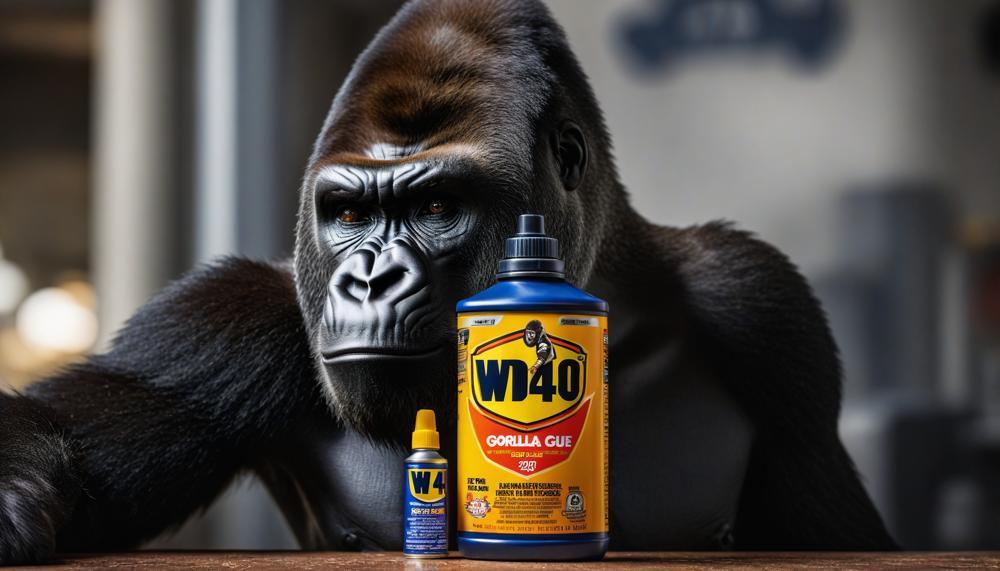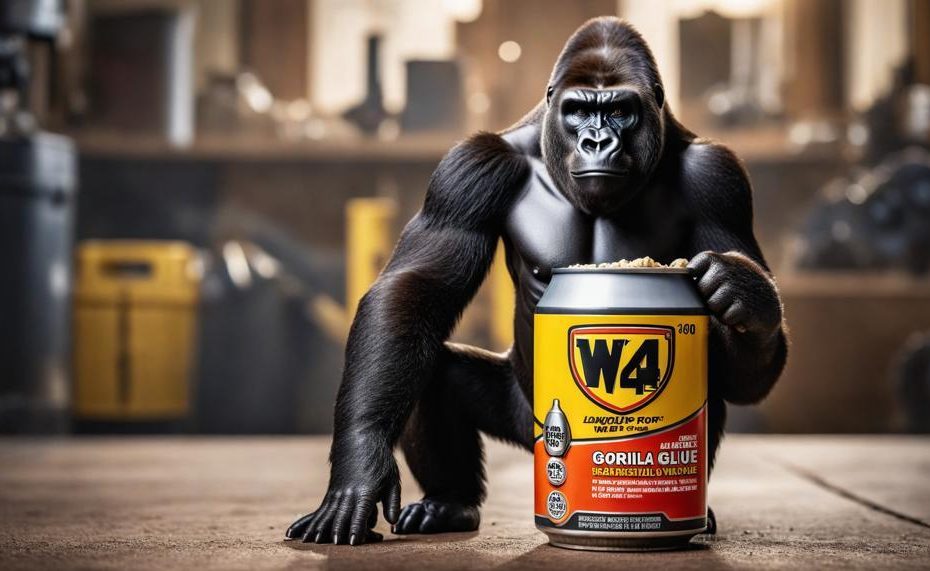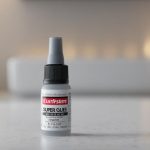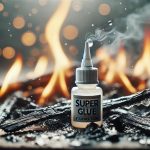No, WD-40 will not effectively remove Gorilla Glue. Gorilla Glue is known for its incredible strength and durability, making it a favorite for tough projects—but also a headache to remove. WD-40, a versatile lubricant, might seem like a quick fix, but its chemical properties don’t break down the strong bond Gorilla Glue forms with surfaces. Instead, you’ll likely end up with a greasy residue that complicates removal efforts.
If you’re facing the stubborn task of getting rid of Gorilla Glue, there are better options available:
- Sanding or Scraping: For fresh spills, sanding or scraping off the glue before it fully cures can save you a lot of trouble.
- Acetone or Rubbing Alcohol: These solvents are effective in dissolving Gorilla Glue bonds. Apply with caution and patience for best results.
- Vinegar: Particularly useful on wood, vinegar can soften the glue, making it easier to scrape away.
While WD-40 might loosen the glue in some situations, it’s generally not recommended due to the greasy residue it leaves behind. For a smoother removal process, consider these alternative methods first. Dive into the details to discover why these solutions are more effective and how to use them safely.
Table of Contents
What is Gorilla Glue?
Gorilla Glue is a renowned adhesive known for its exceptional strength and versatility. It is a polyurethane-based glue, which sets it apart from many other adhesives. Here’s a detailed look at Gorilla Glue and its unique features compared to other types of glue:
Characteristics of Gorilla Glue
- Polyurethane Composition: Gorilla Glue expands as it cures, creating a strong, foaming bond that penetrates deep into the materials being joined. This composition makes it ideal for heavy-duty applications.
- Versatility: It can bond a wide variety of materials, including wood, metal, ceramic, stone, and certain plastics.
- Waterproof: Once cured, Gorilla Glue is waterproof, making it suitable for outdoor and indoor projects alike. It can withstand exposure to moisture without breaking down.
- Temperature Resistance: It can handle both high and low temperatures, maintaining its bond strength in extreme conditions.
- Strength and Durability: The adhesive is incredibly strong, often stronger than the materials it joins, ensuring a long-lasting bond.
Comparison with Other Types of Glue
| Type of Glue | Composition | Key Features |
| Gorilla Glue | Polyurethane | Expands upon curing, waterproof, bonds various materials, temperature-resistant, extremely strong |
| Super Glue (Cyanoacrylate) | Cyanoacrylate | Quick-drying, strong but brittle, best for small repairs, not waterproof, can bond skin |
| White Glue (PVA) | Polyvinyl Acetate | Non-toxic, easy to clean, dries clear, best for porous materials like wood and paper, not waterproof |
| Epoxy | Epoxide resin and hardener | Two-part adhesive, extremely strong, waterproof, chemical-resistant, best for metal and complex repairs |
| Wood Glue | Various (PVA, aliphatic resin) | Specifically for wood, strong bond with wood fibers, not typically waterproof |
Removal and Cleanup
- Before Curing: It is best to clean up Gorilla Glue before it cures using acetone or rubbing alcohol.
- After Curing: Once cured, Gorilla Glue can be tough to remove. Sanding, scraping, or using a chisel may be necessary. For softer materials, vinegar can help soften the glue for easier removal.
What is WD 40?
WD-40 is a versatile water displacement spray known for its multifaceted applications. Originally developed to prevent corrosion, it combines lubricants with anti-corrosion agents. The name “WD” stands for “Water Displacement,” highlighting its primary function, while “40” refers to the number of attempts it took to perfect the formula. It is primarily used as a lubricant, rust preventive, penetrant, and moisture displacer.
How Does WD-40 Work?
WD-40 works by forming a thin, protective layer that shields surfaces from moisture and corrosion. Here’s a closer look at its components and functions:
| Function | Action | Applications |
| Lubrication | Reduces friction and wear | Bike chains, hinges, gears |
| Rust Prevention | Forms a barrier against moisture | Tools, car parts, machinery |
| Penetration | Loosens stuck parts | Bolts, nuts, screws |
| Moisture Displacement | Drives out moisture | Electrical circuits, engines |
Key Ingredients

WD-40 contains a blend of hydrocarbons and lubricants. The hydrocarbons evaporate, leaving behind the lubricants and anti-corrosion agents to provide long-lasting protection.
Does WD 40 Remove Gorilla Glue?
Yes, WD-40 can be effective in removing Gorilla Glue. However, it may not completely dissolve the adhesive. The solvents in WD-40 help to weaken the bond of the glue, making it easier to remove.
Here is a detailed step-by-step method for using WD-40 to remove Gorilla Glue:
| Step | Action | Details |
| 1 | Prepare the Surface | Remove excess glue with a scraper or putty knife. |
| 2 | Apply WD-40 | Spray WD-40 generously on the glue. |
| 3 | Let it Sit | Wait for 10-15 minutes. |
| 4 | Scrape Off the Glue | Gently remove the softened glue with a scraper. |
| 5 | Clean the Area | Wash with soapy water and dry thoroughly. |
Why Might WD 40 Not Be Effective in Removing Gorilla Glue?
WD 40 might not always be effective in removing Gorilla Glue due to the distinct chemical compositions of the two substances. Gorilla Glue is a polyurethane-based adhesive, known for creating extremely strong mechanical bonds that are resistant to various solvents.
WD 40, a multipurpose lubricant, is not formulated to break down the strong polyurethane bonds formed by Gorilla Glue. Additionally, using WD 40 can leave a greasy residue that complicates the removal process further.
Alternative Methods for Removing Gorilla Glue
| Method | Effectiveness | Best Used On |
| Sanding | High | Wood, Metal |
| Specialized Adhesive Removers | High | Various Surfaces |
| Acetone | Medium | Fresh Glue |
| Rubbing Alcohol | Medium | Semi-Dry Glue |
| Vinegar and Baking Soda | Medium | Non-sensitive Surfaces |
Other Ways to Remove Gorilla Glue
Removing Gorilla Glue can be challenging due to its strong adhesive properties. Here are some effective alternatives to using WD-40:
Acetone or Fingernail Polish Remover
Acetone is highly effective at dissolving Gorilla Glue, particularly on metal surfaces. Simply apply acetone or nail polish remover containing acetone to the glue, let it sit for a few minutes, and then wipe away with a cloth.
Rubbing Alcohol (Isopropyl Alcohol)
Rubbing alcohol can break down the glue’s bond. Apply a generous amount of isopropyl alcohol to a cloth and rub it on the affected area until the glue begins to dissolve.
Lemon Oil
For a natural solution, lemon oil can help remove minor glue stains. Apply lemon oil to the glue spot and let it soak in. Then, gently scrub the area with a soft cloth.
Vinegar
Vinegar can soften Gorilla Glue on wood surfaces. Soak a cloth in vinegar and apply it to the glue, allowing it to sit for several hours. The glue should become easier to scrape off afterward.
Sanding or Scraping
Before the glue fully dries, sanding or scraping it off can be effective. Use a putty knife or sandpaper to remove as much of the glue as possible. This method works best on wood and plastic surfaces.
Heat
Applying heat can soften Gorilla Glue, making it easier to remove. Use a hairdryer or heat gun on a low setting to warm the glue. Once softened, scrape it off with a putty knife.
Conclusion
Removing Gorilla Glue can be a challenging endeavor, and using WD-40 for this purpose might not be the best choice.
Gorilla Glue’s robust polyurethane composition forms a strong bond that WD-40, a versatile lubricant and moisture displacer, can’t effectively break down. Instead of dissolving the glue, WD-40 is more likely to leave a greasy residue, complicating the removal process.
For more effective removal methods, consider the following approaches:
- Sanding or Scraping: For recent spills, mechanical removal through sanding or scraping is highly effective. It’s crucial to tackle the glue before it fully cures to save time and effort.
- Acetone or Rubbing Alcohol: These solvents are particularly efficient in breaking down Gorilla Glue. By applying them with care and patience, you can dissolve the adhesive bond, making it easier to wipe away.
- Vinegar: This common household item is particularly useful on wood. Vinegar can soften the glue, facilitating its removal with minimal damage to the underlying material.
While WD-40 might seem like a handy solution, it’s not recommended due to its ineffectiveness in breaking down the adhesive properties of Gorilla Glue. Instead, opt for sanding, scraping, or using solvents like acetone or vinegar for a smoother and cleaner removal process.






